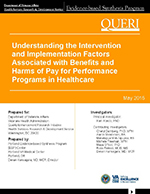
Principal Investigator: Karli Kondo, PhD Contributing Investigators: Cheryl Damberg, PhD, MPH; Aaron Mendelson, BA; Makalapua Motu'apuaka, BS; Michele Freeman, MPH; Maya O'Neil, PhD; Rose Relevo, MLIS, MS; Devan Kansagara, MD, MCR
Download PDF: Complete Report, Executive Summary, Report, Appendices
Over the last decade, pay for performance (P4P) programs have been implemented in a variety of health systems, including the VHA, as a means to improve the efficiency and quality of health care. There has been a parallel increase in the number of studies examining the effects of P4P. A number of recent reviews have summarized this literature, but have generally found insufficient evidence to broadly characterize the balance of harms and benefits. However, financial incentives programs are complex interventions whose effects may depend in part on the settings in which they are implemented, the methods used for implementation, the populations targeted, and the characteristics of the incentive programs themselves.
The objectives of this report are to summarize the positive and negative effects of P4P on process and health outcomes, and to examine how implementation characteristics modify the effects of P4P programs.
Key Question 1: What are the effects of pay for performance programs on patient outcomes and processes of care?
Key Question 2: What implementation factors modify the effectiveness of pay for performance?
Key Question 3: What are the positive and negative unintended consequences, including any effect on health disparities, associated with pay for performance?
Mendelson A, Kondo K, Damberg C et al. The Effects of Pay-for-Performance Programs on Health, Health Care Use, and Processes of Care: A Systematic Review. Annals of Internal Medicine. 2017;166(5):341-353. DOI: 10.7326/M16-1881.
Kondo K, Damberg C, Mendelson A, Motu'apuaka M, Freeman M, O'Neil M, Relevo R, Low A, Kansagara D. Implementation processes and pay for performance in healthcare: A systematic review. Journal of General Internal Medicine. 2016;31(Suppl 1):S61-9. DOI: 10.1007/s11606-015-3567-0.
Francis J and Clancy C. Implementing performance pay in health care: Do we know enough to do it well? Journal of General Internal Medicine. Published online 03/07/16.
Caution Advised for Pay-for-Performance Programs (Management eBrief)